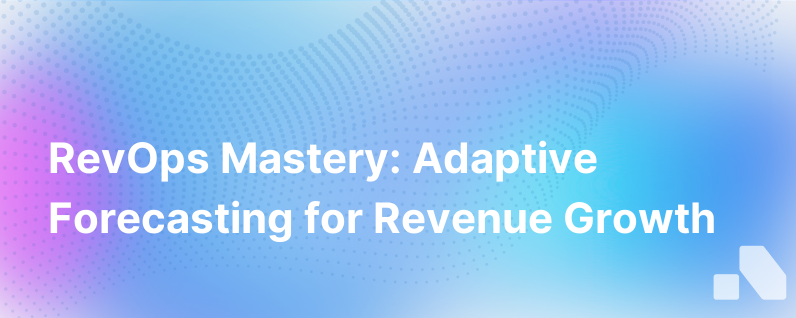Revenue Operations With Adaptive Forecasting
Published on November 12, 2023 by Sawyer Middeleer
Businesses that have mastered the art of adaptability are often the ones that thrive. In today's fast-paced, ever-changing market landscape, the ability to forecast adaptively is critical. Revenue operations is one area where adaptability has become increasingly crucial.
Adaptive forecasting is not just about predicting the future but being agile enough to make real-time changes to business operations based on those predictions. In revenue operations, it means aligning sales, marketing, and customer success efforts with current data trends to optimize revenue streams.
Here, we will explore the concept of adaptive forecasting within revenue operations, including its importance and how to implement it effectively.
Understanding Adaptive Forecasting
Adaptive forecasting differs from traditional forecasting by its very nature of being flexible and dynamic. Traditional methods rely on historical data and static models, but adaptive forecasting incorporates the latest data, real-time analysis, and can adjust to market trends and unexpected changes rapidly.
It encompasses areas that traditional forecasting often misses – like sudden shifts in buying behavior, economic fluctuations, market entrants, or new competition – and allows an organization to pivot swiftly.
The Importance of Adaptive Forecasting in Revenue Operations
The cohesive nature of revenue operations is set to benefit significantly from adaptive forecasting. As sales, marketing, and customer success departments increasingly interconnect, the requirement for a unified view of the forecast is undeniable.
Having an adaptive forecasting model allows an organization to:
- Optimize sales and marketing strategies with real-time data, allowing for immediate adjustments to campaigns or sales tactics.
- Better anticipate market changes, allowing for more proactive measures rather than reactive damage control.
- Improve financial planning and resource allocation, ensuring money is spent in areas that will generate the highest return.
- Enhance customer satisfaction by staying ahead of demand trends and shifting preferences.
Implementing Adaptive Forecasting in Revenue Operations
Start with Integrating Data
Data integration is paramount. Breaking down silos and combining data from across all arms of revenue operations gives a comprehensive picture and ensures all forecasting is based on the same facts.
You need systems that allow for the seamless flow of data from CRM platforms, marketing automation tools, customer engagement platforms, and financial systems. Cloud-based solutions often provide the flexibility and scalability needed for such integration.
Lean on Advanced Analytics
Modern forecasting requires sophisticated analytical tools capable of handling vast amounts of data and identifying patterns quickly. Machine learning and AI-driven analytics can pinpoint trends, test scenarios, and ascertain probabilities with a precision a human analyst might miss.
This is where platforms like Aomni provide invaluable support, as they allow for deep sales data analysis with an AI-driven approach, turning raw data into strategic insights that fuel adaptive forecasting models.
Embrace Continuous Planning
Adaptive forecasting necessitates a shift away from quarterly or annual planning cycles to a model where plans are continuously updated. Moving to a rolling forecast, which updates with each set of new data and trends identified, ensures your revenue operation remains agile and strategy tweaks are timely.
Foster Collaboration across Departments
A successful adaptive forecast requires different departments to collaborate and share insights regularly. Revenue operations act as the core where sales, marketing, and customer service insights converge to drive better financial results.
Setting up regular cross-departmental sync-ups, collaborative platforms, and a culture of shared goals is vital. Communication is critical; without it, effective adaptive forecasting is impossible.
Account for Uncertainty
One of the defining features of adaptive forecasting is its ability to handle uncertainty. This involves developing scenario-based models to predict the impact of various changes in the business landscape on revenue. Then, you create action plans for likely scenarios, ensuring rapid response when one evolves.
Monitor and Refine Constantly
Finally, adaptive forecasting is not a 'set and forget' system. Models need to be continually calibrated with fresh data and adjusted based on actual outcomes versus forecasts. This cyclic process helps refine future forecasts, ensuring they become more accurate over time.
Best Practices for Revenue Operations Forecasting
- Use the Right Tools: Invest in forecasting software that incorporates machine learning and AI to help predict outcomes more accurately.
- Shorten Forecast Intervals: Shift to a weekly or monthly forecast system, rather than quarterly or annually, to remain adaptable.
- Boost Forecast Accuracy: Constantly compare the forecast data against actual outcomes to adjust your predictive models accordingly.
- Encourage Cross-functional Communication: Sales, finance, marketing, and customer success need to work together for an accurate revenue picture.
- Be Proactive in Approach: Don’t wait for trends to disrupt your operations; anticipate them and implement changes preemptively.
- Educate and Train your Team: Ensure that every stakeholder understands the adaptive forecasting process and is aware of their role in maintaining it.
Conclusion
Adaptive forecasting represents an evolution in how companies approach their revenue operations—the transition from a rigid, hindsight-focused mechanism to a dynamic, foresight-driven process. It allows businesses to be nimble, respond to changes swiftly, and captures opportunities before the competition.
In the end, it is not merely about predicting what will happen but positioning your business to respond to whatever might happen effectively. That's the essence of driving operations with adaptive forecasting, and it is indispensable for future-proofing revenue streams in an unpredictable world.
As businesses adapt to using adaptive forecasting in their revenue operations, they benefit from platforms like Aomni that facilitate real-time data analysis, aiding in quicker, more informed strategic decisions that align with ever-shifting market demands.